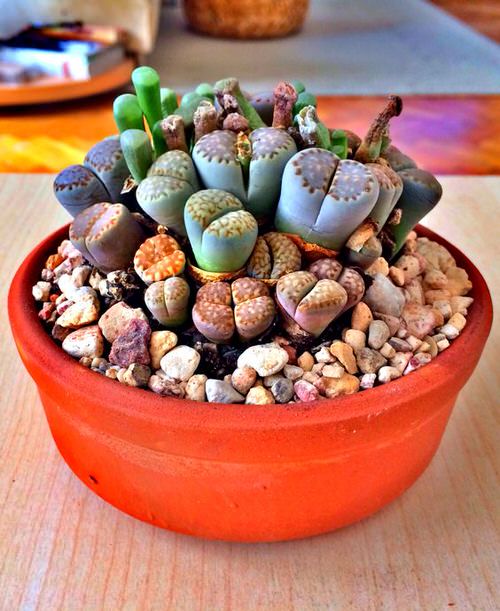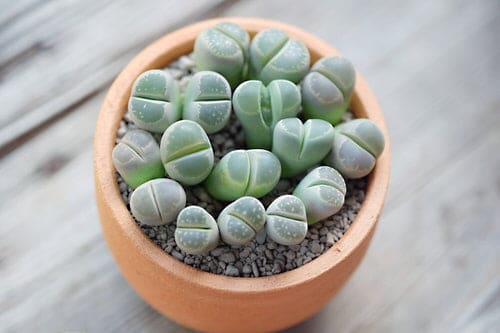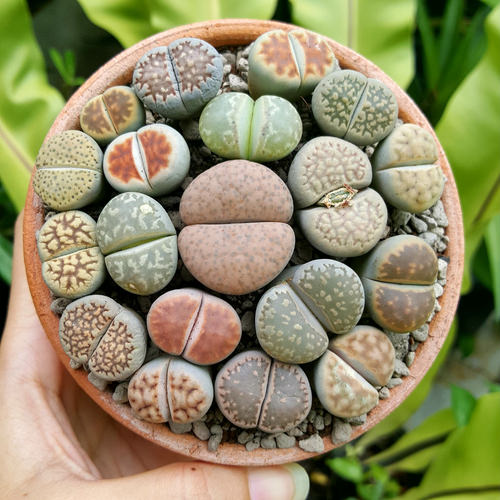Learn everything about Lithops Care and how to grow this strange plant that looks like a couple of colored rocks in a pot!

Popularly known as living stones and pebble plants, lithops are colorful succulent plants that look fantastic in all types of decor. Lithops Care is fuss-free and we’ll guide you in detail on how to grow them easily!
USDA Zones: Can be grown in all the zones as a houseplant
Other Names: Pebble Plant, Living Stones Plant
What are Lithops?

Lithops are popular as ‘living stones’ as they closely resemble the rocks that surround them so that animals don’t eat them. Living in extremely adverse conditions, they adapted to them, developing the ability to store large amounts of water in their low and distended leaves and in sprouting pairs of short underground stems.
Popular Lithops Varieties

There are about 40 species of Lithops among which some of the most popular are:
- Lithops localis: Mostly used for landscaping, this ornamental variety features gray-green leaves with several bright dots on top.
- Lithops hookeri: Living stones with the largest leaves, the ‘hookeri’ comes in multiple shades of red, brown, orange, or pink.
- Lithops salicola: Comparatively smaller variety which blooms showy white flowers with yellow dots. Botanists call it a salt-dwelling living stone.
- Lithops optica: An endangered species, the ‘optica’ has a window on top, in between the leaves. The Rubra species is the most common lithops optical.
- Lithops ruschiorum: Appears like sandstones, this variety comes in pale gray color with dark gray spots, giving it a crumbled look,
- Lithops aucampiae: The leaves of this variety have large windows, allowing sunlight to penetrate to deep, blooms bright yellow daisy-like flowers.
- Lithops lesliei: The ‘lesliei’ is popular for the various colors it comes in, also this variety camouflages well with the surroundings to ditch its predators.
- Lithops viridis: Lithops with a uniform color, the ‘viridis’ comes in gray-green color with pinkish tint at the edge.
- Lithops verruculosa: The brown variety resembles coffee beans, the ‘verruculosa’ is a flowering species that bloom pinkish flowers in the fall.
- Lithops dinteri: The ‘dinteri’ forms small flat leaves with a convex top. This species possesses an extensive root system and needs large pots to grow.
Growing Lithops from Seeds

Growing Lithops is possible from seeds and cuttings. Seeds are best sown in summer in temperate regions or when the weather is warm enough. In the tropics, you can start seeds anytime except in summer.
To protect the seeds from dryness they are covered with a thin layer of sand. Until the germination, the substrate must be kept slightly damp and a container is covered with foil. Seeds germinate within a few days.
Young seedlings should remain in the same container for as long as possible. For proper development, they need a lot of light. After a few months, you can transplant them into the pots. Lithops grown from seeds get the ability to flower after about three years.
Tip: As the plant is really a slow grower, it would be a good idea to get it from a nursery or a garden center.
Best Pot Size for Growing Lithops

Lithops have a large root system than the rest of the plants that grow above the surface. Go for 6-10 inches of pot.
Requirements for Growing Lithops

Position
Keep the plant on a location facing South or West, where it’ll receive a lot of exposure to the sun. The position can be airy, but remember, these plants don’t like cold drafts. In the tropics keep the plant in a spot that receives filtered sunlight most of the day.
Soil
Lithops likes a very well-drained soil that is poor in organic matter. The permeable substrate should be provided with the addition of gravel and sand.
You can also use the potting mix available for cacti and succulents with an addition of 20% more sand or perlite. On the surface of the soil in the pot, you can put small pebbles or gravel to get an additional decorative effect.
Watering
Lithops should be watered deeply but irregularly. In temperate climates, it blooms in fall (autumn) and at this time, it must be watered two-three times deeply in a month until the end of fall.
In the remaining months, Lithops require a period of dormancy. During that time, Lithops care is needed. It must not be watered in that period but remember that soil must not become bone dried.
For this, you can lightly spray the leaves with water, time to time in this period. You can resume watering once the plant sets the first couple of young leaves, which usually occurs in summer in temperate regions and in winter in the tropics.
Lithops Care

Fertilization
Don’t fertilize the pebbles plant. Fertilizing it weakens its tissues and makes it susceptible to rot.
Overwintering
Lithops care in winter is important. Once the blooming period ends Lithops should be given a period of rest (usually from late November until March, *in temperate zones). During this period of time, it must not be watered. However, you can spray the plant from time to time. Maintain the temperature constant at the level of 50 – 60 F (10 to 15 C).
Pests and Diseases
Lithops care from pests is not much required as it rarely gets attacked by them. Even so, sometimes it gets infested by mealybugs. Lithops is susceptible to rot. It happens due to several reasons like overwatering or waterlogged or non-draining soil.



I have purchased Lithops on line from Oz Lithops.
There were 8 and only 2 survived. I’ve just given
them a first water since 8 weeks (looking crinkly).
I’ve grown seeds in cotton wool and succulent mix
with gravel and sand. They are nearly the size of
a pea. I’ve been keeping them moist in a seal top
bag. North facing near window with indirect light.
Could you please tell me when the seedlings can
be less watered? Thank You. Kind Regards, Glenn.
After they make their first set of leaves. Cut the watering and moisture immediately.
I have a new lithops that I just got I October 2018. In December I moved and during the transition the little guy got damaged. There were two tiny nicks of flesh taken out of the side. I wasn’t sure what to do so didn’t do anything. I thought it might repair itself but it just kept getting worse. Now I dont think it can be saved. The nick has grown to a gaping hole and it looks like it may have some bacteria or something growing and some rot😢. Is there anything I can do to save it?
Can you put isopropyl alcohol on a qtip to dusenfect and cut it out w a sharp knife?
We just planted lithops but they were not seeds. they had a small root attached. We bought a shallow clay pot and planting mix for succulents. We were told to wet the soil before we planted them. Then we made a small hole for each lithop and planed the root. The rest of the lithop is sticking up out of the soil. Then we covered the top of the soil with small white stones. We have them sitting on our balcony which gets sunlight. is there anything else we can do? How fast will they grow? Thank you.